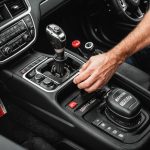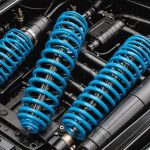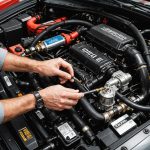Overview of Brake Fluids
Brake fluids are crucial in ensuring a vehicle’s braking system performs effectively, especially in high-performance vehicles. These vehicles often operate under extreme conditions that demand top-notch efficiency and safety from their brake systems. Understanding the different brake fluid types is essential for maintaining both performance and safety.
Brake fluids serve as the medium through which the force is transferred from the brake pedal to the brake pads. This medium must withstand high temperatures without boiling and maintain a consistent viscosity to function properly. Choosing the right brake fluid is fundamental to achieving optimal performance and protecting against potential brake failures.
Topic to read : Essential Tips for Effective Fuel Line Insulation in UK Performance Vehicles
Brake Fluid Types and Performance
- DOT 3 and DOT 4: Commonly used in regular vehicles, they offer adequate performance but may not meet the demands of high-performance environments.
- DOT 5.1: Designed for racing and high-performance vehicles, this fluid provides a higher boiling point to keep braking consistent under intense heat.
- Silicone-based DOT 5: Rarely used in racing due to compatibility issues, it is known for its non-hygroscopic properties, meaning it doesn’t absorb moisture.
For racers and high-performance enthusiasts, the selection of brake fluid can significantly affect driving safety and efficiency. By ensuring that the appropriate type is used, one can enhance the vehicle’s stopping power and reliability.
Key Attributes of High-Performance Brake Fluids
In high-performance scenarios, the boiling point of brake fluids is paramount. Vehicles driven at high speeds generate tremendous heat, and a high boiling point ensures the fluid remains stable, preventing vapour lock and maintaining braking effectiveness. An inadequate boiling point can lead to brake failure, as vaporisation within the braking system interrupts hydraulic pressure.
Topic to read : Choosing the Perfect Suspension Springs for Your British Car: Optimize Your Ride for City Driving
Moreover, viscosity plays a critical role in fluid dynamics, particularly during racing conditions. High-performance brake fluids must maintain their flow characteristics under a wide temperature range to ensure consistent pedal response. If viscosity is too high, it may delay fluid movement and pedal feel; too low, and it risks leakage and inefficiency.
Corrosion protection is another crucial attribute for both longevity and safety of braking systems. Brake components are susceptible to corrosion due to moisture absorption over time. Quality fluids incorporate additives that guard against rust and physical deterioration, ensuring reliable performance over the lifespan of the vehicle. This protection is vital, as corrosion can lead to leaks and compromise braking safety.
High-performance brake fluids, therefore, must balance a high boiling point, optimal viscosity, and robust corrosion protection to meet the demands of high-speed, high-stakes driving scenarios.
Compatibility with British Racing Car Models
Exploring the relationship between British racing car models and their brake fluid compatibility presents a world of precision and performance.
Overview of Popular British Racing Car Models
British racing cars, known for their engineering grandeur, include classics like the Aston Martin Vantage, Lotus Elise, and McLaren F1. Each of these marvels demands a specific type of attention and care, ensuring optimal performance on and off the track. The intricacies of their brake systems necessitate a clear understanding, especially when you venture into the competitive arena. These models, renowned for innovation and speed, require equally outstanding brake fluids to maintain their legacy.
Recommended Brake Fluids for Each Model
For these high-performance machines, finding the right brake fluid is crucial. For instance, DOT 4 fluids are commonly recommended, emphasizing thermal resistance and anti-corrosive properties essential for racing. As the Aston Martin Vantage requires more robust options, upgraded racing DOT 4 variants are advised. Whereas the Lotus Elise benefits from traditional DOT 4, ensuring stability in longer races.
Considerations for Brake System Changes
For car enthusiasts modifying their vehicles, understanding how these alterations might affect brake fluid compatibility is vital. Modifications can alter pressure levels, heat generation, and the overall balance of the car. Consequently, it’s important to choose fluids that can withstand these changes, making sure the racing experience remains safe and exhilarating.
Expert Reviews and Performance Comparisons
In the pursuit of top-tier brake fluid performance, expert reviews reveal invaluable insights. These reviews, often the product of meticulous testing and analysis, are essential for anyone looking to optimize their vehicle’s braking system. Experts evaluate high-performance brake fluids using rigorous performance benchmarking methods, assessing variables such as boiling point, moisture absorption, and viscosity under varying temperatures.
Performance benchmarking involves a series of standardized tests that replicate real-world conditions. This ensures the brake fluid not only meets but often exceeds industry standards. Such testing methodologies help identify the products that deliver consistent performance even under high-stress conditions, like in motorsport applications.
A breakdown of expert insights also involves comparing the best-rated products by dissecting their performance metrics. Top contenders typically possess a high dry and wet boiling point, ensuring reliability in extreme conditions. Additionally, the ability to resist moisture absorption and maintain proper viscosity is crucial for sustained performance over time.
In-demand products stand out thanks to their detailed performance reviews, showcasing robust results in diverse testing scenarios. Understanding these evaluations helps consumers make informed decisions, especially when maximum braking efficiency is the goal. This approach enriches one’s understanding of what makes a brake fluid truly excel in its category.
Practical Tips for Brake Fluid Maintenance
Ensuring the performance longevity of your vehicle’s brake system requires diligent brake fluid maintenance. High-performance brake fluid typically demands attention every one to two years, depending on driving conditions and manufacturer guidelines. Regular inspections will flag potential issues, ensuring your vehicle maintains optimal brake performance.
To effectively check your brake fluid, locate the reservoir under your vehicle’s bonnet. Before opening, clean the cap to prevent contaminants from entering the system. Unscrew the cap and visually inspect the fluid level and condition. High-performance brake fluid should appear clear to slight amber in colour. If the fluid is dark or murky, it is likely time for a replacement. The use of a brake fluid tester is advised to measure water content, which affects brake efficiency.
Application instructions for replacing brake fluid involve a careful process. First, ensure you have the correct type of brake fluid specified in your vehicle manual. Using a turkey baster, remove old fluid from the reservoir. Replenish with new fluid, then bleed each brake line. This requires a partner to pump the brake pedal while you open and close the bleed valves, ensuring air bubbles are purged. Repeat this process until new fluid visibly emerges, free from air bubbles. Proper maintenance following these guidelines can significantly prolong brake system efficiency.
Recommended Brands and Products
Choosing the right brake fluid is crucial for optimal vehicle performance, particularly in high-demand conditions such as racing. Recognizing top brake fluid brands ensures reliability and efficiency. Brands such as Castrol and Brembo are often highlighted for their consistent high performance, promising enhanced braking capabilities. Selecting from these manufacturers can provide confidence, adaptive responses, and security during demanding rides.
Overview of Leading Brands
Brand reputation plays a vital role in product selection. For example, Castrol is renowned for its technological advancements, focusing on formulations that withstand high temperatures without compromising safety. Meanwhile, Brembo is celebrated for its longevity, maintaining effectiveness through extended periods of high usage.
Product Specifications
When examining product specifications for high-performance brake fluids, several factors stand out:
- High boiling points ensure effectiveness under strenuous conditions.
- Synthetic formulas provide consistent viscosity, which ensures braking performance isn’t compromised in various climates.
- Compatibility with various systems, reducing the risk of reactions that could affect braking.
These product specifications serve as benchmarks for ensuring racing suitability.
Consumer Feedback
Consumer feedback consistently praises these brands for their unparalleled performance. Early adopters report a noticeable improvement in braking reaction times and reduced wear over extended use. User experiences are overwhelmingly positive, indicating these products are likely to meet the demands of professional and amateur racers alike, contributing to the brands’ strong reputations.











